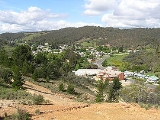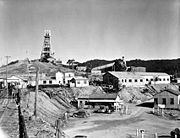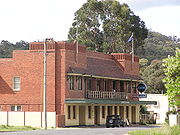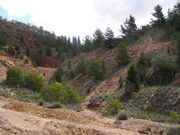
Captains Flat, New South Wales
Encyclopedia
Captains Flat is a town in the Southern Tablelands
of New South Wales
, Australia
, in Palerang Shire
. It is south of Queanbeyan
.
It is suggested that a bullock named "Captain" from Foxlow station, 12 km away, grazed here and hence the place name.
The area was originally inhabited by Ngarigu Aboriginals
prior to European settlement. The town formed as a result of mining for gold
, silver
, lead
, zinc
, copper
and iron pyrites
in the hills surrounding the upper reaches of the Molonglo River
. The town boomed from 1881 to 1899 then went into a rapid decline until 1939 when rail access revived mining activity for another 23 years.
 Copper was found in the area in 1874 by JE Wright of Foxlow station. The Molonglo goldfield was declared in 1882 and mining for gold and silver commenced at two mines, Koh-i-noor and Commodore, which were operated by two mining companies. Two blast furnace
Copper was found in the area in 1874 by JE Wright of Foxlow station. The Molonglo goldfield was declared in 1882 and mining for gold and silver commenced at two mines, Koh-i-noor and Commodore, which were operated by two mining companies. Two blast furnace
s were built in 1885. The two companies merged in 1894 and formed the Lake George United Mining and Smelting Company. Up to that time the mines had produced mainly copper with some silver and a small amount of gold. Processing was made harder because of the presence of zinc. To convey ore to the bins at the smelter, the company built a 2 ft (610mm) tramway in 1897. Trains of small 4-wheel dump cars were hauled by a Krauss steam locomotive. The tramway appears to have closed about 1902. In the early twentieth century the mine produced gold and copper. Mining activity ceased in 1920.
The impact on Europe
an markets due to World War II
meant mining operations were subsidised by the government through power and freight concessions as the foreign revenue was seen as important to the Australian economy. In 1940, 550 people were employed and the local population was 1700. The mining company, Lake George Mines, built 152 fibro
cottages for married miners, a hostel for single men and some of the population lived in tents. The company also built a theatre, hospital tennis courts and a swimming pool, paid for the medical staff, the provision of street lighting, electricity and water.
 In the 1930s and 40s many of the old buildings were replaced including the hotel. The new hotel built in 1938 was said to have the longest bar in Australia
In the 1930s and 40s many of the old buildings were replaced including the hotel. The new hotel built in 1938 was said to have the longest bar in Australia
at the time; it was 32 metres long.
There were some significant strikes
by the miners in the 1940s and 50s. The strike of 1948/49 and the lockout of 1954/55 both lasted for seven months. The mine closed on 11 March 1962 due to the lack of viable ore. To that point men had worked in tunnels extending 840 metres (2,800 feet) below the ground. From 1939 to 1962 just over 4 million tonnes of ore was extracted containing 1.5 million tonnes of concentrates: 39% of which were zinc, 33% pyrites, 24% lead, 5% copper, and small amounts of gold (2850 tonnes) and silver (155 tonnes). Immediately after the closure the Lake George Mines dismantled and sold the infrastructure including removing many of the cottages.
 The railway closed on 31 August 1968 but reopened for a few weeks in 1969 for the filming of the movie "Ned Kelly".
The railway closed on 31 August 1968 but reopened for a few weeks in 1969 for the filming of the movie "Ned Kelly".
The impact of sulphur and acid rain produced by the smelting
has resulted in the area around the mines having a stark and somewhat alien landscape reminiscent of Queenstown
in Tasmania
.
In the 1939 and 1942 mine tailings
and slime dams collapsed into the Molonglo River. The resulting pollution severely damaged the ecological communities of the Molonglo River downstream from the mine site, and eradicated all native fish populations. Despite Federal and NSW government funded remediation programs of $2.5m in 1976, toxic leachates still enter the river from the Captains Flat mine site. The remediation works covered the waste dumps with impermeable clay and vegetation designed to reduce the risk of catatastrophic failure of the dumps. The owners of the mine were not held accountable for the pollution nor contributed to the remediation of the environmental impact. A large stretch of the Molonglo is still devoid of native fish and waiting for native fish species to be re-established.
Prospecting has commenced in the area again, begun by Monaro Mining and apparently now largely taken over by Ironbark Gold.
Southern Tablelands
The Southern Tablelands is a geographic area of the State of New South Wales, Australia. This area is located west of the Great Dividing Range.The area is characterised by flat country which has generally been extensively cleared and used for grazing purposes...
of New South Wales
New South Wales
New South Wales is a state of :Australia, located in the east of the country. It is bordered by Queensland, Victoria and South Australia to the north, south and west respectively. To the east, the state is bordered by the Tasman Sea, which forms part of the Pacific Ocean. New South Wales...
, Australia
Australia
Australia , officially the Commonwealth of Australia, is a country in the Southern Hemisphere comprising the mainland of the Australian continent, the island of Tasmania, and numerous smaller islands in the Indian and Pacific Oceans. It is the world's sixth-largest country by total area...
, in Palerang Shire
Palerang Council
The Palerang Council is a Local Government Area in the Southern Tablelands Region of New South Wales, Australia. It is on the Kings Highway and the Sydney-Canberra railway....
. It is south of Queanbeyan
Queanbeyan, New South Wales
Queanbeyan is a regional centre in the Southern Tablelands in south-eastern New South Wales adjacent to the Australian Capital Territory. The city's mixed economy is based on light construction, high technology, manufacturing, service, retail and agriculture. It is the council seat of the...
.
It is suggested that a bullock named "Captain" from Foxlow station, 12 km away, grazed here and hence the place name.
The area was originally inhabited by Ngarigu Aboriginals
Indigenous Australians
Indigenous Australians are the original inhabitants of the Australian continent and nearby islands. The Aboriginal Indigenous Australians migrated from the Indian continent around 75,000 to 100,000 years ago....
prior to European settlement. The town formed as a result of mining for gold
Gold
Gold is a chemical element with the symbol Au and an atomic number of 79. Gold is a dense, soft, shiny, malleable and ductile metal. Pure gold has a bright yellow color and luster traditionally considered attractive, which it maintains without oxidizing in air or water. Chemically, gold is a...
, silver
Silver
Silver is a metallic chemical element with the chemical symbol Ag and atomic number 47. A soft, white, lustrous transition metal, it has the highest electrical conductivity of any element and the highest thermal conductivity of any metal...
, lead
Lead
Lead is a main-group element in the carbon group with the symbol Pb and atomic number 82. Lead is a soft, malleable poor metal. It is also counted as one of the heavy metals. Metallic lead has a bluish-white color after being freshly cut, but it soon tarnishes to a dull grayish color when exposed...
, zinc
Zinc
Zinc , or spelter , is a metallic chemical element; it has the symbol Zn and atomic number 30. It is the first element in group 12 of the periodic table. Zinc is, in some respects, chemically similar to magnesium, because its ion is of similar size and its only common oxidation state is +2...
, copper
Copper
Copper is a chemical element with the symbol Cu and atomic number 29. It is a ductile metal with very high thermal and electrical conductivity. Pure copper is soft and malleable; an exposed surface has a reddish-orange tarnish...
and iron pyrites
Pyrite
The mineral pyrite, or iron pyrite, is an iron sulfide with the formula FeS2. This mineral's metallic luster and pale-to-normal, brass-yellow hue have earned it the nickname fool's gold because of its resemblance to gold...
in the hills surrounding the upper reaches of the Molonglo River
Molonglo River
The Molonglo River rises on the western side of the Great Dividing Range of eastern Australia in the state of New South Wales. Its source is on the other side of the mountain range from where the Shoalhaven River rises, in Tallaganda state forest at ~1200 metres altitude...
. The town boomed from 1881 to 1899 then went into a rapid decline until 1939 when rail access revived mining activity for another 23 years.

Blast furnace
A blast furnace is a type of metallurgical furnace used for smelting to produce industrial metals, generally iron.In a blast furnace, fuel and ore and flux are continuously supplied through the top of the furnace, while air is blown into the bottom of the chamber, so that the chemical reactions...
s were built in 1885. The two companies merged in 1894 and formed the Lake George United Mining and Smelting Company. Up to that time the mines had produced mainly copper with some silver and a small amount of gold. Processing was made harder because of the presence of zinc. To convey ore to the bins at the smelter, the company built a 2 ft (610mm) tramway in 1897. Trains of small 4-wheel dump cars were hauled by a Krauss steam locomotive. The tramway appears to have closed about 1902. In the early twentieth century the mine produced gold and copper. Mining activity ceased in 1920.
The impact on Europe
Europe
Europe is, by convention, one of the world's seven continents. Comprising the westernmost peninsula of Eurasia, Europe is generally 'divided' from Asia to its east by the watershed divides of the Ural and Caucasus Mountains, the Ural River, the Caspian and Black Seas, and the waterways connecting...
an markets due to World War II
World War II
World War II, or the Second World War , was a global conflict lasting from 1939 to 1945, involving most of the world's nations—including all of the great powers—eventually forming two opposing military alliances: the Allies and the Axis...
meant mining operations were subsidised by the government through power and freight concessions as the foreign revenue was seen as important to the Australian economy. In 1940, 550 people were employed and the local population was 1700. The mining company, Lake George Mines, built 152 fibro
Fibro
Fibro, the shortened form of "Fibrous Cement" - or "Fibrous Asbestos Cement", FAC, is a building material made of compressed fibres cemented into rigid sheets....
cottages for married miners, a hostel for single men and some of the population lived in tents. The company also built a theatre, hospital tennis courts and a swimming pool, paid for the medical staff, the provision of street lighting, electricity and water.

Longest bar in Australia
As with any such statistic, there are a number of claims for the title "the longest bar in Australia":* Captains Flat, New South Wales: When the new hotel was built in 1938 was said to have the longest bar in Australia at the time; it was long....
at the time; it was 32 metres long.
There were some significant strikes
Strike action
Strike action, also called labour strike, on strike, greve , or simply strike, is a work stoppage caused by the mass refusal of employees to work. A strike usually takes place in response to employee grievances. Strikes became important during the industrial revolution, when mass labour became...
by the miners in the 1940s and 50s. The strike of 1948/49 and the lockout of 1954/55 both lasted for seven months. The mine closed on 11 March 1962 due to the lack of viable ore. To that point men had worked in tunnels extending 840 metres (2,800 feet) below the ground. From 1939 to 1962 just over 4 million tonnes of ore was extracted containing 1.5 million tonnes of concentrates: 39% of which were zinc, 33% pyrites, 24% lead, 5% copper, and small amounts of gold (2850 tonnes) and silver (155 tonnes). Immediately after the closure the Lake George Mines dismantled and sold the infrastructure including removing many of the cottages.

The impact of sulphur and acid rain produced by the smelting
Smelting
Smelting is a form of extractive metallurgy; its main use is to produce a metal from its ore. This includes iron extraction from iron ore, and copper extraction and other base metals from their ores...
has resulted in the area around the mines having a stark and somewhat alien landscape reminiscent of Queenstown
Queenstown, Tasmania
Queenstown is a town in the West Coast region of the island of Tasmania. It is located in a valley on western slopes of Mount Owen on the West Coast Range.It had a population of 5,119 people . At the 2006 census, Queenstown had a population of 2,117....
in Tasmania
Tasmania
Tasmania is an Australian island and state. It is south of the continent, separated by Bass Strait. The state includes the island of Tasmania—the 26th largest island in the world—and the surrounding islands. The state has a population of 507,626 , of whom almost half reside in the greater Hobart...
.
In the 1939 and 1942 mine tailings
Tailings
Tailings, also called mine dumps, slimes, tails, leach residue, or slickens, are the materials left over after the process of separating the valuable fraction from the uneconomic fraction of an ore...
and slime dams collapsed into the Molonglo River. The resulting pollution severely damaged the ecological communities of the Molonglo River downstream from the mine site, and eradicated all native fish populations. Despite Federal and NSW government funded remediation programs of $2.5m in 1976, toxic leachates still enter the river from the Captains Flat mine site. The remediation works covered the waste dumps with impermeable clay and vegetation designed to reduce the risk of catatastrophic failure of the dumps. The owners of the mine were not held accountable for the pollution nor contributed to the remediation of the environmental impact. A large stretch of the Molonglo is still devoid of native fish and waiting for native fish species to be re-established.
Prospecting has commenced in the area again, begun by Monaro Mining and apparently now largely taken over by Ironbark Gold.
Notable people
- Mark GableMark GableMark Gable is the front man and a founding member of the Australian rock band The Choirboys. The band was formed in Sydney in 1979. Mark was born in Captains Flat in New South Wales in 1950.- External links :...
, singer and songwriter for The ChoirboysThe ChoirboysThe Choirboys may refer to:*Choirboy, a boy member of a choir, also known as a treble*The Choirboys , a 1975 novel by Joseph Wambaugh*The Choirboys , a 1977 film adaptation of the novel starring Perry King...
, was born in Captains Flat
External links
- Webpage of the Captains Flat Community Association containing numerous internal and external links to interesting information about the village and surrounding area.

